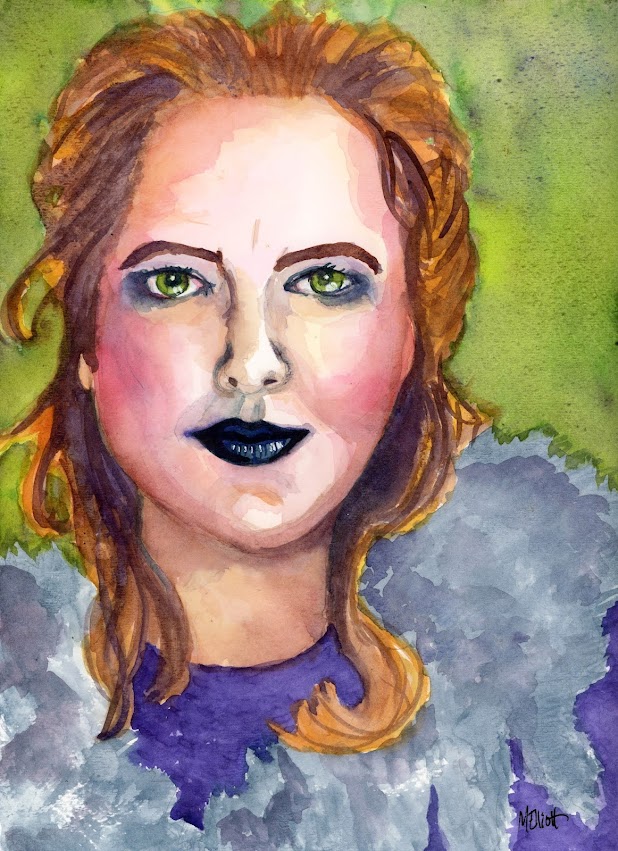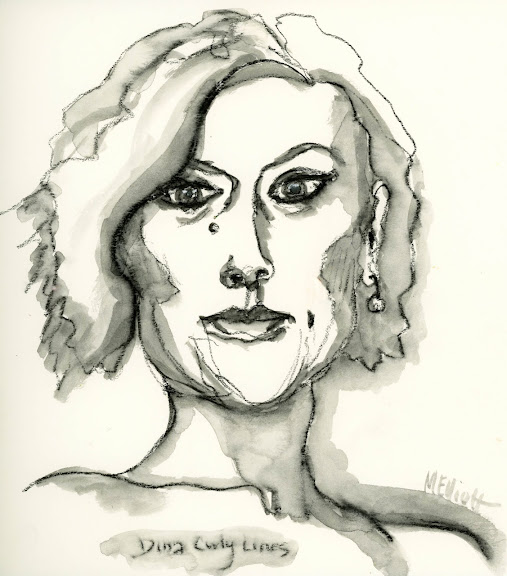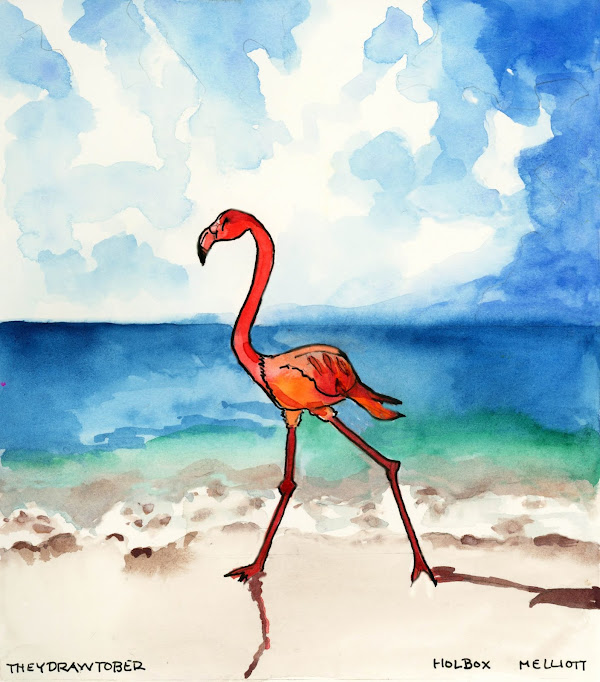30 December 2021
The electronic critic
28 December 2021
Pensive
26 December 2021
The power of suggestion
20 December 2021
Overlooked artists
Despite her successes and exhibitions, Salvador Dali dismissed her work as "better than most, perhaps, but creativity is in the testicles." (One wonders if Dali's was the body on the table depicted by her in "The Anatomy Lesson." All the girls and women are looking at him with a degree of disgust surely deserved by that remark!)
19 December 2021
Don't waste paint
I haven't posted any art for 10 days because I haven't been able to paint. I went in a week ago last Wednesday to the podiatrist to get him to remove a small piece of glass from the bottom of my foot (in the arch right in front of the heel). I had broken a drinking glass in the kitchen about a year ago and, walking around barefoot in the summer, managed to pick up a stray piece in my foot that the broom didn't find. I immediately went to Urgent Care, where they numbed the foot, tweezed out the piece of glass, put on a Bandaid, and that was an end of it. Except that over the past few months I discovered there was still some glass in there. Perhaps it was deeper and had gradually migrated back up to the surface? but now I was feeling it when I pressed down on the spot or set my foot down unwarily, so I wanted to get it out of there.
Turns out, though, that there was no glass; instead, my foot had created a "plantar keratosis" in the spot where the previous piece of glass had been removed. So the doctor cut it open a lot wider than he had planned and removed the keratosis, and then he gave me six stitches, a bandage, a wrap, a sock, a boot, and a prescription for antibiotics, and told me it would take three to four weeks to heal! Talk about throwing a wrench into the Christmas season—not only has it been difficult to get around on it, but if I don't keep it elevated for a good part of the day, it hurts. So sitting at my desk painting for a few hours at a time hasn't been an option.
I have had one bandage change now, however, and taken all the antibiotics, and it's doing better. So I decided yesterday that I would paint a picture as a gift for someone. I painstakingly laid down a grid on the page so that the drawing would be accurate, then did the base drawing and started to paint, but after more than two hours' work it was turning into the most dreadful thing I have ever attempted, and I decided not to waste any more time on it.
That is a really long explanation to get me to the title of this blog post, which is about not wasting paint.
The one thing that Emma Petitt says at least once and usually several times during every lesson is "don't waste paint." If you have a little white paint left, go back and hit your highlights one more time. If you have another color that goes with something in your painting—hair, background, clothing, whatever—then take your paintbrush and slap it in there. Leave that palette bare by the end!
Since I just started painting with acrylics this year, however, I haven't yet got good judgment about how much paint it takes. I inevitably either run out and have to add more, or overestimate from the beginning and have a bunch left of at least one but usually three or more colors. So since one of the tricks I have also picked up from Emma is creating interesting abstract backgrounds over which to paint my portraits, I am now making it a habit to pick up a pad of paper and my brayer (roller) at the end of the current painting and use the remaining paint on my palette to create the next background. Sometimes they turn out well, and sometimes they sit for a while before I can figure out how to use them, but either way, I feel relief that I'm not throwing away expensive art supplies!
So last night, when I gave up on that painting, I had paint left on my palette, and I used it for a new background. There were a lot of colors, and it came out pretty dark and intense; but there were some nice combinations and juxtapositions. This morning I gave up on sleep at 5 a.m. and got onto the computer to write a review of the book I finished at 1:00 before going to sleep; then I made myself some breakfast, did a few light chores, and thought about what to do for the rest of the day. The chores made sitting down for a while a necessity, and my eye was drawn to that new background.
The other thing I have learned with the abstract backgrounds (this from Deb Weiers) is to look and see if there is already a "picture" contained within them, just waiting to be released. Sure enough, this one had a face and a couple of pseudo-Princess-Leia buns (that ended up translating to giant blossoms) staring out at me. So I looked around for a reference photo that would work, and found a dark-visaged girl with her features at the appropriate angle who was begging to be my model.
This is a little different from most I have done, in that I was so reluctant to cover up the interesting background that I did minimal coverage with the paint. Instead of using a big brush with broad strokes, I used a fairly tiny one and did almost a dry-brush effect on the face, using small dabs of paint and scrubbing them into the surface so that the underlayer wouldn't be completely obscured. Then I did the opposite on the clothing, by using a large brush with a thinned-out coat of paint that would darken without blotting out the underlayer. Between the two, I'm happy with her emergence from but lack of contrast with the background.
I also wanted a more definitive line than my usual Uniball, given the dark and challenging background, so I used a black Posca pen, which I think worked well. I'm pretty happy with her—and yes, I used the leftover paint for my next background!
Posca Pen and acrylic paints on Fluid 140-lb. coldpress watercolor paper, 9x12 inches.
07 December 2021
Last LFI2021
06 December 2021
The beauty of substrate
04 December 2021
It's done...I think?
02 December 2021
Getting my nerve up
Today I finally went back to my first real "canvas" painting, which is also my first with full figure, and actually with two of them. I ended up imposing a grid over the photo and then duplicating it on the canvas so as to locate everything properly, although the proportions were not identical and I fear that the vertical boxes on the painting will be a bit elongated. But since I am not going for an entirely literal portrait but rather doing a more abstract study of light and shadow, I don't think there will be any harm done.
So far, I have put in the preliminary drawing, which has already gone through multiple changes and I'm sure will evolve further as I get out the paintbrushes. In fact, just the act of photographing it and looking at the photo shows me where I need to make adjustments—funny how different things look once they're in a still shot.
I'm a little nervous about the whole thing, but it's also exciting to try something new. I'm taking a lunch break and then breaking out the paints.
Oh, and as a bonus...a rare photo of the uncooperative model Gidget, in her perch on the patio in front of my prolific lemon tree.20 November 2021
A new substrate
 |
| This is an example of Deanna's. (She's also doing some kind of thing with masking tape, but we didn't do that part.) |
Canvas
18 November 2021
Challenges
12 November 2021
The Mighty Quinn
06 November 2021
Random
05 November 2021
Fitting it in
30 October 2021
Wrapping up the prompts
28 October 2021
Tiny lesson doodles
25 October 2021
Phillis
22 October 2021
Empathy
20 October 2021
I love portraits
19 October 2021
Time for tea
17 October 2021
Yummy
I couldn't get out with my local group today for International Urban Sketchers Day (knees are currently too sketchy for long walks, ha!), so instead I did double duty, making an urban sketch of my local doughnut shop, and also fulfilling today's prompt from #theydrawtober, which was "donuts."
Uniball pen and watercolors in Bee Sketchbook.
15 October 2021
Combining prompts
https://www.adashofmegnut.com/roasted-acorn-squash-fall-salad/
13 October 2021
Affirmation
I painted it during my first flush of frantic activity after taking Deb Weiers's class and finding out about the versatility and brightness of acrylic inks. It was one of a number of public figures whose faces and quotes I wanted to share, but no one seemed to want to buy one and put it in their home...until now.
12 October 2021
Strong Light
"Strong Light"—charcoal pencil, acrylic paints, Stabilo All brown pencil, on 140-lb. Fluid coldpress watercolor paper, 12x16 inches.
10 October 2021
Spicy!
Today's food prompt was "spicy cocktail," and while I'm not a drinker I am always fascinated at the ideas people come up with for mixed drinks. I would never think to combine all the things that are in the "Tropical Burn," especially the jalapeño and the cilantro, but I can (barely) imagine that they mix together to create a unique flavor! I mainly tackled this because I thought rendering the ingredients would be fun, which it was. I wish I had paid a little more attention when creating the written list of ingredients and fit them in a little better around the illustrated items, but oh well, sometimes it's just spontaneous and that's how it is.
Now, some adventurous soul make this, taste it, and tell me if it works!
"Spicy Cocktail"—pencil, Uniball pen, watercolors, in Bee sketchbook.
09 October 2021
31 Islands
08 October 2021
31 flavors
Nope, not ice cream—it's one of the three themes for theydrawtober, and today's prompt was "chestnuts." Do you know how boring chestnuts are? I mean, if you want to really show off your ability to imitate lifelike light and shadow, you can grab a handful, put a light on them, and try to copy the shine, but...hm. I finally decided to do just one, and do it cracked open but mostly inside its outer shell, which is prickly and in my favorite lime green.
In the process of looking for a reference photo, I picked up a few facts: Chestnuts are more like fruit than they are like nuts, with a high water content and little or no protein or fat. They are mostly carbohydrates and sugars, comparing with wheat or rice, and have twice as much starch as potatoes. We don't grow many in the States because of chestnut blight, but import a lot from other countries. Various delicacies are made with chestnuts, typically by the French (marrons glacée) and Italians but also by the Hungarians and Swiss, and a liqueur in Portugal. Other cultures mill chestnuts into flour for baking, use them as stuffing for poultry, ferment them for beer, and roast them as a coffee substitute. They are well-used, therefore, despite their repelling outer shell!
"Chestnut"—Uniball and watercolor in Bee Sketchbook.
07 October 2021
31 Flowers
06 October 2021
Yesterday and today
I took yesterday's prompt from the food list, although rather than presenting "figs" as first occurred to me (an hors d'oeuvre plate featuring sliced fruit, cheese and crackers), I instead depicted them being devoured by green June bugs before I can get them off the tree and into my mouth! When I pull a fig, miraculously still intact, off my tree, a swarm of these bandits rise up from the fruit they are in the process of hollowing out and circle my head with a loud buzzing sound like tiny battery-operated airplanes! I try first to scope out where the beetles are on the tree and duck to one side as I attempt to salvage my figs, but sometimes the June bugs end up in my hair. You have to really love figs to argue with these guys!
















































